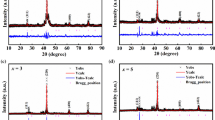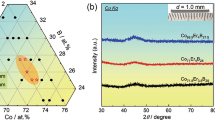Abstract
Low-temperature and low-field magnetocaloric materials with high magnetocaloric effect (MCE) performance have important prospects in applications such as gas liquefaction. A series of polycrystalline Er1−xYxCr2Si2 (0 ≤ x ≤ 0.8) samples were successfully synthesized by arc melting, showing giant low-field MCE. For the sample with x = 0.1, the compound shows the best MCE performance, with the appropriate working temperature down to 2 K. Furthermore, the maximum value of magnetic entropy change ((−ΔSM)max) and adiabatic temperature change ((ΔTad)max) under the field change of 0–1 T are calculated to be 19.2 J kg−1 K−1 and 4.3 K correspondingly. The value of (−ΔSM)max is the largest ever reported for intermetallic MCE materials below 20 K. The characteristic of magnetic phase transition is verified to be of second order on basis of Arrott plots, mean field theory and rescaled universal −ΔSM curves. The physical mechanism indicates that the great enhancement of (−ΔSM)max as large as 15.9% due to 10% Y substitution originates from the larger saturation magnetic moments and the smaller saturated magnetic fields.
摘要
高性能低温低场磁热材料在气体液化等领域具有重要的应用前 景. 本团队通过真空电弧熔炼的方式成功合成了一系列多晶 Er1−xYxCr2Si2 (0 ≤ x ≤ 0.8)样品, 这些材料表现出巨大的低场磁热效应. 其中Cr含量为0.1的样品显示出最好的低场磁热性能以及接近2 K的合 适的工作温区. 更重要的是, 在0–1 T的磁场变化下, 该样品的最大磁熵 变峰值以及最大绝热温变峰值分别高达19.2 J kg−1 K−1和4.3 K. 其磁熵 变峰值为目前已报道的20 K以下温区合金类磁热材料的最大值. 通过 Arrott曲线, 平均场理论以及约化磁熵变曲线等手段, 证明了磁相变特 征为二级相变. 物理机理分析表明, 10%的Y替代导致高达15.9%的磁熵 变峰值增强的原因在于替代样品所具有的大饱和磁化强度以及小饱和 磁场.

Similar content being viewed by others
References
Moya X, Mathur ND. Caloric materials for cooling and heating. Science, 2020, 370: 797–803
Hou H, Qian S, Takeuchi I. Materials, physics and systems for multi-caloric cooling. Nat Rev Mater, 2022, 7: 633–652
Gottschall T, Gràcia-Condal A, Fries M, et al. A multicaloric cooling cycle that exploits thermal hysteresis. Nat Mater, 2018, 17: 929–934
Pecharsky VK, Gschneidner K.-A.J., Pecharsky AO, et al. Thermodynamics of the magnetocaloric effect. Phys Rev B, 2001, 64: 144406
Pecharsky VK, Gschneidner Jr KA. Giant magnetocaloric effect in Gd5(Si2Ge2). Phys Rev Lett, 1997, 78: 4494–4497
Hu F, Shen B, Sun J, et al. Influence of negative lattice expansion and metamagnetic transition on magnetic entropy change in the compound LaFe11.4Si1.6. Appl Phys Lett, 2001, 78: 3675–3677
Cong D, Xiong W, Planes A, et al. Colossal elastocaloric effect in ferroelastic Ni–Mn–Ti alloys. Phys Rev Lett, 2019, 122: 255703
Krenke T, Duman E, Acet M, et al. Inverse magnetocaloric effect in ferromagnetic Ni-Mn-Sn alloys. Nat Mater, 2005, 4: 450–454
Wada H, Tanabe Y. Giant magnetocaloric effect of MnAs1−xSbx. Appl Phys Lett, 2001, 79: 3302–3304
Tegus O, Brück E, Buschow KHJ, et al. Transition-metal-based magnetic refrigerants for room-temperature applications. Nature, 2002, 415: 150–152
Giguere A, Foldeaki M, Schnelle W, et al. Metamagnetic transition and magnetocaloric effect in ErCo2. J Phys-Condens Matter, 1999, 11: 6969–6981
Castro PB, Terashima K, Yamamoto TD, et al. Machine-learning-guided discovery of the gigantic magnetocaloric effect in HoB2 near the hydrogen liquefaction temperature. NPG Asia Mater, 2020, 12: 35
Li DX, Yamamura T, Nimori S, et al. Large reversible magnetocaloric effect in ferromagnetic semiconductor EuS. Solid State Commun, 2014, 193: 6–10
Guillou F, Pathak AK, Paudyal D, et al. Non-hysteretic first-order phase transition with large latent heat and giant low-field magnetocaloric effect. Nat Commun, 2018, 9: 2925
Xu JW, Zheng XQ, Yang SX, et al. Giant low field magnetocaloric effect in TmCoSi and TmCuSi compounds. J Alloys Compd, 2020, 843: 155930
Zheng XQ, Zhang B, Wu H, et al. Large magnetocaloric effect of HoxEr1−xNi (0 ≤ x ≤ 1) compounds. J Appl Phys, 2016, 120: 163907
Li L, Nishimura K, Hutchison WD, et al. Giant reversible magnetocaloric effect in ErMn2Si2 compound with a second order magnetic phase transition. Appl Phys Lett, 2012, 100: 152403
Zhang Y, Zhu J, Li S, et al. Magnetic properties and promising magnetocaloric performances in the antiferromagnetic GdFe2Si2 compound. Sci China Mater, 2022, 65: 1345–1352
Guo D, Moreno-Ramírez LM, Law JY, et al. Excellent cryogenic magnetocaloric properties in heavy rare-earth based HRENiGa2 (HRE = Dy, Ho, or Er) compounds. Sci China Mater, 2022, 66: 249
Zhang Y, Li S, Hu L, et al. Excellent magnetocaloric performance in the carbide compounds RE2Cr2C3 (RE = Er, Ho, and Dy) and their composites. Mater Today Phys, 2022, 27: 100786
Li L, Yan M. Recent progress in the development of RE2TMTM’O6 double perovskite oxides for cryogenic magnetic refrigeration. J Mater Sci Tech, 2023, 136: 1–12
Xu P, Hu L, Zhang Z, et al. Electronic structure, magnetic properties and magnetocaloric performance in rare earths (RE) based RE2BaZnO5 (RE = Gd, Dy, Ho, and Er) compounds. Acta Mater, 2022, 236: 118114
Zhang Y, Tian Y, Zhang Z, et al. Magnetic properties and giant cryogenic magnetocaloric effect in B-site ordered antiferromagnetic Gd2MgTiO6 double perovskite oxide. Acta Mater, 2022, 226: 117669
Lionte S, Risser M, Muller C. A 15 kW magnetocaloric proof-of-concept unit: Initial development and first experimental results. Int J Refrigeration, 2021, 122: 256–265
Maiorino A, Mauro A, Del Duca MG, et al. Looking for energy losses of a rotary permanent magnet magnetic refrigerator to optimize its performances. Energies, 2019, 12: 4388
Shen J, Gao X, Li K, et al. Experimental research on a 4 K hybrid refrigerator combining GM gas refrigeration effect with magnetic refrigeration effect. Cryogenics, 2019, 99: 99–104
Law JY, Franco V, Moreno-Ramírez LM, et al. A quantitative criterion for determining the order of magnetic phase transitions using the magnetocaloric effect. Nat Commun, 2018, 9: 2680
Yakinthos JK. Crystal and magnetic structures of TmFe2Si2 and TmNi2Ge2 compounds. Influence of the d-metal charge on the anisotropy direction of the RT2X2 (R = rare earth, T = 3d or 4d metal and X = Si, Ge) compounds. J Magn Magn Mater, 1991, 99: 123–132
Moze O, Hofmann M, Buschow KHJ. Chromium sublattice magnetic ordering in a compound of the ThCr2Si2 type structure: HoCr2Si2. J Alloys Compd, 2000, 308: 60–63
Moze O, Rosenkranz S, Osborn R, et al. Magnetic excitations in tetragonal HoCr2Si2. J Appl Phys, 2000, 87: 6283–6285
Saensunon B, Stewart GA, Nishimura K. Crystal field interaction at the Tm3+ site in TmCr2Si2. J Alloys Compd, 2009, 476: 49–53
Janatová M, Vejpravová JP, Diviš M. Magnetic properties of RCr2Si2 compounds (R = Tb, Er). J Magn Magn Mater, 2010, 322: 1140–1142
Li L, Hu G, Umehara I, et al. Magnetic properties and magnetocaloric effect of GdCr2Si2 compound under hydrostatic pressure. J Alloys Compd, 2013, 575: 1–4
Moze O, Hofmann M, Cadogan JM, et al. Magnetic order in RCr22Si2 intermetallics. Eur Phys J B - Condensed Matter, 2003, 36: 511–518
Li L, Hutchison WD, Huo D, et al. Low-field giant reversible magnetocaloric effect in intermetallic compound ErCr2Si2. Scripta Mater, 2012, 67: 237–240
Toby BH. EXPGUI, a graphical user interface for GSAS. J Appl Crystlogr, 2001, 34: 210–213
Cui J, Huang Q, Toby BH. Magnetic structure refinement with neutron powder diffraction data using GSAS: A tutorial. Powder Diffr, 2012, 21: 71–79
Yang SX, Zheng XQ, Yang WY, et al. Tunable magnetic properties and magnetocaloric effect of TmGa by Ho substitution. Phys Rev B, 2020, 102: 174441
Green RW, Legvold S, Spedding FH. Magnetization and electrical resistivity of erbium single crystals. Phys Rev, 1961, 122: 827–830
Brommer PE. A generalization of the Inoue-Shimizu model. Physica B-Condensed Matter, 1989, 154: 197–202
Liu XB, Ryan DH, Altounian Z. The order of magnetic phase transition in La(Fe1−xCox)114Si1.6 compounds. J Magn Magn Mater, 2004, 270: 305–311
Mo ZJ, Shen J, Yan LQ, et al. Low field induced giant magnetocaloric effect in TmGa compound. Appl Phys Lett, 2013, 103: 052409
Mo ZJ, Shen J, Yan LQ, et al. Low-field induced giant magnetocaloric effect in TmCuAl compound. Appl Phys Lett, 2013, 102: 192407
Li L, Yuan Y, Zhang Y, et al. Giant low field magnetocaloric effect and field-induced metamagnetic transition in TmZn. Appl Phys Lett, 2015, 107: 132401
Zhang Y, Wilde G. Magnetic properties and magnetocaloric effect in quaternary boroncarbides compound ErNiBC. Physica B-Condensed Matter, 2015, 472: 56–59
Li L, Saensunon B, Hutchison WD, et al. Magnetic properties and large reversible magnetocaloric effect in TmMn2Si2. J Alloys Compd, 2014, 582: 670–673
Zhang H, Xing C, Zhou H, et al. Giant anisotropic magnetocaloric effect by coherent orientation of crystallographic texture and rare-earth ion moments in HoNiSi ploycrystal. Acta Mater, 2020, 193: 210–220
Bebenin NG, Zainullina RI, Ustinov VV, et al. Magnetic properties of La0.7−xPrxCa03MnO3 single crystals: When is Banerjee criterion applicable?. J Magn Magn Mater, 2014, 354: 76–80
Franco V, Conde A, Pecharsky VK, et al. Field dependence of the magnetocaloric effect in Gd and (Er1−xDyx)Al2: Does a universal curve exist?. Europhys Lett, 2007, 79: 47009
Oesterreicher H, Parker FT. Magnetic cooling near curie temperatures above 300 K. J Appl Phys, 1984, 55: 4334–4338
Acknowledgements
This work was supported by the National Key Research and Development Program of China (2021YFB3501202 and 2019YFB2005800), the Science Center of the National Science Foundation of China (52088101), the National Natural Science Foundation of China (51871019, 52171170, 52130103, 51961145305, and 51971026), and the 111 Project (B170003).
Author information
Authors and Affiliations
Contributions
Zheng X designed the idea of this research. Xi L, Liu C, Wang D, Xu J, Yang S, Gao Y and Jin B performed the experiments including sample synthesis, magnetic measurements and XRD analysis. Xu J and Yin W performed the NPD experiments. Zhu M and Xu W performed the TEM experiments. Zheng X performed the data analysis and prepared the original manuscript. All the other authors contributed to the discussion.
Corresponding authors
Additional information
Conflict of interest
The authors declare that they have no conflict of interest.
Supplementary information
Supporting data are available in the online version of the paper.
Lei Xi graduated from the School of Materials Science and Engneering, University of Science and Technoloy Beijing (USTB), and currently he is a PhD student at the School of Materials Science and Engineering, Anhui University (AHU). His research interests focus on magnetic properties and the magnetocaloric effect of rare-earth-based compounds.
Xinqi Zheng recieved his PhD degree from the Institute of Physics, Chinese Academy of Sciences. During his PhD study, he carried out research on neutron powder diffraction of magnetic materials as a guest researcher. Currently, he is an associate professor at the School of Materials Science and Engineering, USTB. His research interest focuses on rare-earth-based low-temperature magnetic refrigerant materials and abnormal magnetic thermal expansion materials.
Electronic Supplementary Material
Rights and permissions
About this article
Cite this article
Xi, L., Zheng, X., Gao, Y. et al. Giant low-field magnetocaloric effect of (Er,Y)Cr2Si2 compounds at ultra-low temperatures. Sci. China Mater. 66, 2039–2050 (2023). https://doi.org/10.1007/s40843-022-2312-0
Received:
Accepted:
Published:
Issue Date:
DOI: https://doi.org/10.1007/s40843-022-2312-0




